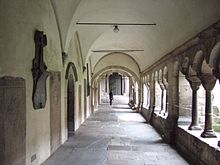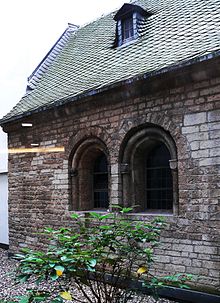Cassius pen
The Cassius-Stift was founded in Bonn by the end of the 7th century at the latest ; It was dissolved in 1802. The most important building of the monastery was the collegiate church “St. Cassius and Florentius ”, today's Bonn Minster .
Names
The monastery bore the name of Cassius , who was venerated as a martyr in Bonn , whose grave, along with the tomb of Florentius, who was also venerated as a martyr, and other martyrs' graves, according to legend, was under the collegiate church.
history
The sarcophagi , in which the mortal remains of the martyrs are said to have been located, are in the immediate vicinity of the place where a memorial for the dead, a cella memoriae, was built in Roman times . The area of the martyrs' graves and the former cella was built over by a hall in the middle of the 6th century. This building was a stone building that stood on mighty foundations made of second-hand matronal altars and other ancient spoils . A number of graves were laid in the building and outside, and the dead were buried until the end of the 8th century.
Obviously, since the end of the 7th century at the latest, the building was considered the grave church of the two Christian martyrs and was the destination of Christian pilgrims . The oldest surviving written source, in which it is about the donation of a winery to the church of St. Cassius and Florentius (" Basilica sancta Cassii et Florentii"), names for 691 (or 692) Giso as the abbot ("Abbas") of the " Basilica ”. Giso is possibly a cleric who became bishop of Cologne a little later . The number of clergy who lived in the area of the church probably grew in the next decades, so that structural extensions were necessary. The appearance of the hall building was changed again and again up to the 8th century through additions and renovations, two grave chapels and several living and utility rooms were added to the original building.
Since the 8th century, foundations for the institution have also been increasingly documented, so that the foundation of the Cassius Foundation can be assumed by the end of the 8th century at the latest. The "Basilica" became the collegiate church "St. Cassius and Florentius ”and fulfilled this function in the following two centuries, in which no further structural changes can be proven. In the 11th century the church was demolished and the cathedral was built in its place .
The collegiate church was not a parish church . The oldest parish church in Bonn, the Dietkirche , was located in the area of the former Roman camp . And also in the Middle Ages it was the church of St. Martin , which is directly adjacent to the minster , that served as a parish church for the surrounding communities.
Organization of the pen
When the monastery was founded, it was the Archbishop of Cologne who headed the monastery as abbot. Possibly it was the first archbishop of Cologne and confidante of Charlemagne , Hildebold , who founded the monastery and held the position of abbot. Since the archbishops were unable to personally manage the business as head of the monastery, they appointed representatives for this purpose. A “custos” is named for the year 801, and from the year 848 it is the provosts in Bonn who play this role.
In the Middle Ages it was not necessary for the provost to be a clergyman himself; on the contrary, this office was often taken over by aristocrats, as it was associated with great benefices . Another advantage was that the provost was usually exempt from the residence obligation.
If the provost was appointed by the archbishop until the 11th century , the chapter increasingly emancipated itself and later chose its leader himself through free choice. However, this led to more and more tensions, as the Curia also tried to exert a strong influence and, through the direct intervention of the Popes, the posts were often filled by curials, often cardinals. The struggle for the influence of various interest groups led to rapid changes in provost posts or even to double occupations.
Probably the most important provost of the Archdiocese of Cologne was the Cassius Foundation. For many centuries the provost was the second most powerful man after the archbishop and his income exceeded that of the Cologne cathedral provost by two times and that of his Mainz colleague by four times. Not least because of this there was an ongoing struggle for supremacy among the monasteries.
Head and provost of the Cassius-Stift (selection)
| 691 (692) | Giso ("Abbot") |
| 787 | Hildebold |
| at 842-849 / 853 | Thegan |
| 1124-1169 | Gerhard of Are |
| 1169-1192 | Lothar von Hochstaden |
| 1192 | Bruno von Sayn |
| 1211-1225 | Heinrich von Müllenark |
| 1313-1328 | Heinrich von Virneburg |
| 1371-1378 | Robert of Geneva |
| 1397-1414 | Dietrich von Moers |
| 1534-1537 | Friedrich von Wied |
| 1546-1559 | Johannes Gropper |
| 1594-1596 | Peter Gropper |
| 1629-1661 | Franz Wilhelm von Wartenberg |
Building of the monastery
The most important building of the Bonn monastery was the collegiate church, today's cathedral. The spiritual center was the choir in front of the high altar . The canons and vicars gathered in the choir stalls for prayer times and daily worship.
Other monastery buildings were the chapter house, the cloister and the canons' apartments located within the city district. One of these apartments belonged to the Helenenkapelle , which has been preserved to this day and was built in the 12th century . Your location is in Bonn, Am Hof 36.
Sources
Up until the 16th century, the Bonn monastery owned a copy book , a collection of copies of documents from the 7th to 10th centuries. "With the beginning of 643 it belonged to the longest known collection of copies of the German Empire, the age of which is probably only equal to that of the Stavelot-Malmedy Monastery, " wrote the Bonn historian Wilhelm Levison in 1932. Like other treasures and institutions of the Cassius Foundation, so the archive and with it the collection of copies became victims of the Truchsessian War at the end of the 16th century. When the Bonn canon Quirinius Palanth rearranged and inventoried the remains of the archive that had survived in 1610, he was unable to cite a document that was before 1110. For that year there was a deed of donation from Archbishop Friedrich I of Cologne .
If we can still get a picture of the copy book today and have a limited number of copies of documents from the monastery, it is thanks to the imperial mint master and notary Johann Helman, who died in Cologne in 1579 at the age of almost 50. Helman left u. a. Copies and extracts from the Bonn volume. It was Wilhelm Levison who edited the estate in 1932 and made it accessible to the public.
Individual evidence
- ^ Wilhelm Levison: The Bonn documents of the early Middle Ages , p. 236.
- ↑ Christoph Keller: Legend put to the test. In: Archeology in Germany , 5/2006, p. 35.
- ^ Dietrich Höroldt: Das Stift St. Cassius zu Bonn: From the beginnings of the church up to the year 1580 , p. 45.
- ^ Wilhelm Levison: The Bonn documents of the early Middle Ages , p. 218.
literature
- Wilhelm Levison: The Bonn documents of the early Middle Ages. In: Bonner Jahrbücher of the Association of Friends of Antiquity in the Rhineland and the Rhenish Provincial Museum in Bonn , issue 136/137, Bonn and Darmstadt 1932.
- Dietrich Höroldt : The St. Cassius Abbey in Bonn. From the beginnings of the church up to 1580 (= Bonner Geschichtsblätter, Volume 11 ), City Archives and City History Library Bonn, 1957.
- Manfred Koch: The minster, formerly the collegiate church of St. Cassius and Florentius . Schnell and Steiner Verlag, Regensburg 1990.
- Jürgen Kaiser: The Bonn Minster - History - Architecture - Art - Cult , Regensburg 2002.
- For the provosts see: Josef Niesen : Bonner Personenlexikon. 3rd, improved and enlarged edition. Bouvier, Bonn 2011, ISBN 978-3-416-03352-7 .




